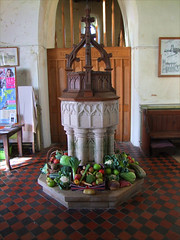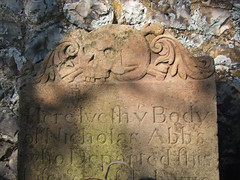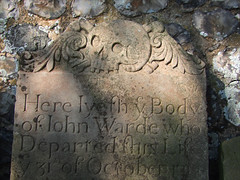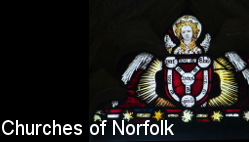| |
|
St Mary,
Roughton I love the little
churches scattered through the narrow high-hedged lanes
to the south of Cromer and Sheringham. Beautifully set,
full of interest and open every day, they are a delight
to cycle around. Many are little-known to outsiders, but
Roughton, pronounced to rhyme with cow-t'n, is larger and
will be more familiar than most because it is on the main
road between Norwich and Cromer.
Despite the nearby busy road the setting is lovely, the
rolling hills covered in woods and a sense of the sea a
couple of miles off. And best of all, St Mary has one of
the most ancient of East Anglia's round towers, its Saxon
origins revealed by the circular double-splayed windows
about ten feet up, and the rugged triangular-headed
double bell arches. Pevsner tells us that the herringbone
pattern of the carstone at the base of the tower is
generally regarded as an early Norman technique rather
than a Saxon one, but he feels Roughton may be an
exception to this. Whatever, it all feels splendidly old.
The body of the church is surprisingly big, and gives St
Mary a feeling that it is hunching its shoulders. It is
typically East Anglian in a different way, a late
14th/early 15th Century rebuilding with aisles and
clerestory, all overwhelmingly restored by the
Victorians. The whole piece is harmonious and pleasant
and you step into a building which is full of light. The
interior is pretty much entirely 19th Century, with shiny
tiled floors and pitch pine benches, but even this is
interesting, because the benches are numbered, and the
churchwarden's seat is marked in confident Victorian
lettering. The tower arch is curious and beautiful,
echoed by the tiny west window and completing the
perspective. The only coloured glass is in the south
aisle, a fine depiction of three of the Works of Mercy
which Birkin Haward thought might be by the O'Connor
workshop.
The font is one of those you often find in this part of
Norfolk, apparently EE becoming Dec but probably later
than that, and, as Mortlock observes, probably part of an
off-the-shelf collection rather than anything produced
locally. Generally, this is a very pleasing interior, and
so there is no excuse for those glum and glowering faces
up in the clerestory that look down on it all. Give us a
smile for once!
Simon Knott, August 2019
Follow these journeys as they happen at Last Of England
Twitter.
 
  
   
  
 
|
|
|
